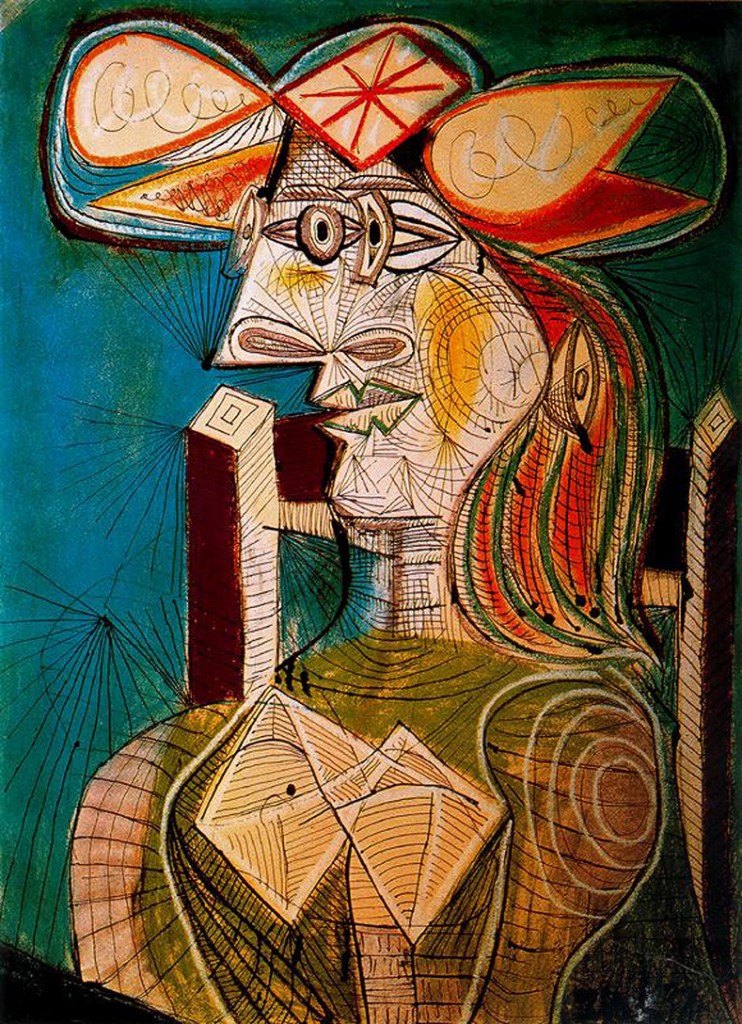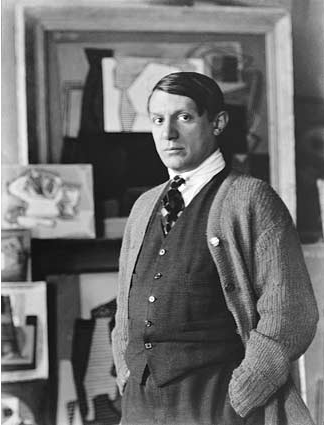The effect of the rise of esteem in the earlier periods of Picasso automatically put a grip on the reception of the later ones as they came off the easel. Since the end of WWII every freshly painted Picasso was greeted with unanimous acclaim by leading critics; none of them wished to take a chance on being proven wrong, as were some of their predecessors of previous generations. And that had a huge impact on the market values. Still, despite the immense prestige and acceptance that Picasso held, the post war works lagged in financial favor compared to earlier periods.

Picasso. Seated Woman on Chair. 1941. Read More:http://www.wikipaintings.org/en/pablo-picasso/seated-woman-on-wooden-chair-1941
Picasso’s later works remond us how great a span of time and ideas in the history of art, indeed of the world, Picasso bridged. His Blue Period dates from his first arrival in Paris around 1900, in th wake of Toulouse-Lautrec, and its raison d’etre grows out of the prevailing impressionist and post impressionist aesthetic of art for art’s sake. But this premise was dismissed by Picasso, at the very latest, by the period commencing with Guernica in 1937. From the moment that the German planes bombed the women and children of this undefended town, Picasso became a politically “committed” artist.

---Poster reproduction of Modigliani portrait of Picasso. 1915. Read More:http://www.globalgallery.com/enlarge/66894/
Or at least he was able to project his at times loveless and hate filled aesthetic, the aggressive idea of art, onto the violence of the fascist movement. It was the ideal foil for his own grotesque, hostile monsters; perhaps Picasso even saw the dogma of the avant-garde within nazi doctrinal kitsch art; threatened by the ideology of their underside yet fascinated by the violence, barbarism, nihilism and intrinsic destruction of the human being ; an affinity that can be regarded as a split off section of themselves, the Janus face.
With WWII the problems of the world became the problems of Picasso’s art, as they did for his idol Goya during the Napoleonic wars. Not alone murder from the sky, horribly premonitive though it has come to be today; also the cruelty of man to other living beings, seen in girls throttling chickens and corn-cobbed peasants brandishing the bloody spears of picadors. All unrepressed versions of the operatically tragic harlequins of the Blue Period and the popular songs of the Analyst Cubist period changed to the up-tempo and dissonant violence and distortion that technological violence could influence.
No artist, except perhaps Titian lived to see their ideas and forms still valid currency among the younger artists of his time. Even Renoir, guiding star of impressionism until his death in 1919 at the age of seventy-eight, saw Picasso’s comet flash twenty years before and unsay most of what he had stated in his life. Abstract expressionism eschewed the always controlled forms and decisive themes of Picasso, but it can’t be said that de Kooning or Pollock could sustain that level high enough in the sky to mean more than Picasso. In the long history of art, it may have just been an earthquake or artistic displacment; there was something in Picasso that foresaw the digital age, the saturated burst of sensation, an underlying software code here touching the same tortuous redemptive fibers that William Blake grappled with. Picasso is still the king that reigns. There is no new one on the throne.
ADDENDUM:
Clement Greenberg ( 1939):We must not be deceived by superficial phenomena and local successes. Picasso’s shows still draw crowds, and T. S. Eliot is taught in the universities; the dealers in modernist art are still in business, and the publishers still publish some “difficult” poetry. But the avant-garde itself, already sensing the danger, is becoming more and more timid every day that passes. Academicism and commercialism are appearing in the strangest places. This can mean only one thing: that the avant-garde is becoming unsure of the audience it depends on — the rich and the cultivated….
"http://dorazora.tumblr.com/post/230873548/kvetchlandia-man-ray-pablo-picaso-1922">

Picasso by Man Ray at age 42.1922 Read More:http://dorazora.tumblr.com/post/230873548/kvetchlandia-man-ray-pablo-picaso-1922
…Macdonald goes on to say: “Why after all should ignorant peasants prefer Repin (a leading exponent of Russian academic kitsch in painting) to Picasso, whose abstract technique is at least as relevant to their own primitive folk art as is the former’s realistic style? No, if the masses crowd into the Tretyakov (Moscow’s museum of contemporary Russian art: kitsch), it is largely because they have been conditioned to shun ‘formalism’ and to admire ‘socialist realism.’”
In the first place it is not a question of a choice between merely the old and merely the new, as London seems to think — but of a choice between the bad, up-to-date old and the genuinely new. The alternative to Picasso is not Michelangelo, but kitsch….
…Let us see, for example, what happens when an ignorant Russian peasant such as Macdonald mentions stands with hypothetical freedom of choice before two paintings, one by Picasso, the other by Repin. In the first he sees, let us say, a play of lines, colors and spaces that represent a woman. The abstract technique — to accept Macdonald’s supposition, which I am inclined to doubt — reminds him somewhat of the icons he has left behind him in the village, and he feels the attraction of the familiar. We will even suppose that he faintly surmises some of the great art values the cultivated find in Picasso. He turns next to Repin’s picture and sees a battle scene. The technique is not so familiar — as technique. But that weighs very little with the peasant, for he suddenly discovers values in Repin’s picture that seem far superior to the values he has been accustomed to find in icon art; and the unfamiliar itself is one of the sources of those values: the values of the vividly recognizable, the miraculous and the sympathetic. In Repin’s picture the peasant recognizes and sees things in the way in which he recognizes and sees things outside of pictures — there is no discontinuity between art and life, no need to accept a convention and say to oneself, that icon represents Jesus because it intends to represent Jesus, even if it does not remind me very much of a man. That Repin can paint so realistically that identifications are self-evident immediately and without any effort on the part of the spectator — that is miraculous. The peasant is also pleased by the wealth of self-evident meanings which he finds in the picture: “it tells a story. ” Picasso and the icons are so austere and barren in comparison. What is more, Repin heightens reality and makes it dramatic: sunset, exploding shells, running and falling men. There is no longer any question of Picasso or icons. Repin is what the peasant wants, and nothing else but Repin. It is lucky, however, for Repin that the peasant is protected from the products of American capitalism, for he would not stand a chance next to a Saturday Evening Post cover by Norman Rockwell.
Ultimately, it can be said that the cultivated spectator derives the same values from Picasso that the peasant gets from Repin, since what the latter enjoys in Repin is somehow art too, on however low a scale, and he is sent to look at pictures by the same instincts that send the cultivated spectator. But the ultimate values which the cultivated spectator derives from Picasso are derived at a second remove, as the result of reflection upon the immediate impression left by the plastic values. It is only then that the recognizable, the miraculous and the sympathetic enter. They are not immediately or externally present in Picasso’s painting, but must be projected into it by the spectator sensitive enough to react sufficiently to plastic qualities. They belong to the “reflected” effect. In Repin, on the other hand, the “reflected” effect has already been included in the picture, ready for the spectator’s unreflective enjoyment. Where Picasso paints cause, Repin paints effect. Repin predigests art for the spectator and spares him effort, provides him with a shore cut to the pleasure of art that detours what is necessarily difficult in genuine art. Repin, or kitsch, is synthetic art. Read More:http://www.sharecom.ca/greenberg/kitsch.html








 COMMENTS
COMMENTS



